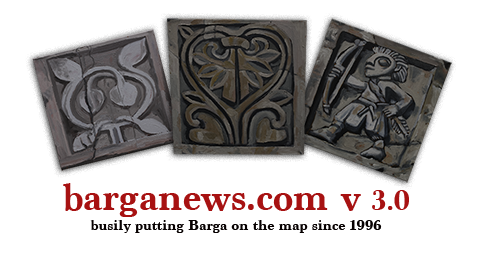
The Annual Palazzo Pancrazi Exhibitions
For forty years the artist Keane has been producing and exhibiting his paintings in many different countries in Europe and around the world but one location has for more than a decade been his preferred location for his annual exhibitions - the atrium of a sixteenth-century palace - Palazzo Pancrazi in Barga, Tuscany, Italy.
Per quarant'anni l'artista Keane ha prodotto ed esposto le sue opere in molti paesi diversi in Europa e in tutto il mondo, ma una sede è stata per più di un decennio la sua preferita per le sue mostre annuali: l'atrio di un palazzo del sedicesimo secolo - il Palazzo Pancrazi a Barga in Toscana, Italia
.
Since the first half of the 14th century, Barga Castle has represented the oldest most northerly outpost of the Florentine. This close relationship with Florence is widely seen by the strong influence that the city exerted on Barghigiano buildings.
In addition to a direct drive through which the “capital” promoted public construction sites in the mid 16th century, it was met with considerable interest by private individuals who went ahead with building their own homes following the tastes that had matured in Florence beginning with the 15th century experiences of Leon Battista Alberti.
This is how the most important Barga families acquired homes that recall the prestigious Florentine palaces in terms of the organisation of their interiors and the layout of the external facades.
Modernisation of the town walls got underway in 1526 and the building work of the first buildings of clear Florentine inspiration began halfway through the century.
Palazzo Balduini was the first, so loyal to the Mannerist modules to make you think that architects from Florence were directly involved, characterised by kneeling windows similar to those in the Florentine Palazzo Grifoni, designed by Ammannati.
Palazzo Pancrazi is also remarkable (now home to the town council), which features elements of the Garfagnana tradition, such as the diamond-shaped ashlar around the doors and windows, also found at Castelnuovo Garfagnana, Diecimo and Pescaglia, as well as typical motifs of Florentine buildings.
Palazzo Angeli bears the coat-of-arms of the Angeli family and the Medici, sign of the family’s obedience to its rulers.
The combination of the types of the town’s buildings with a medieval town’s road network makes these buildings one of a kind. They have the prestige of having imported a building model from beyond its walls, amalgamating this with a new proposal of the themes of the rustic architecture of the Serchio Valley in an elegant style.
All of his work over the past 40 years can be seen here

